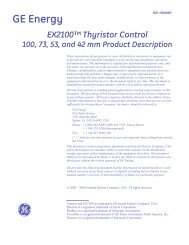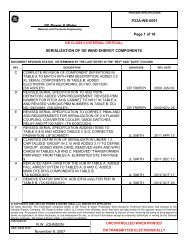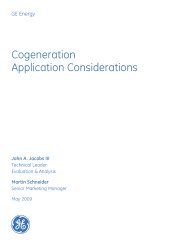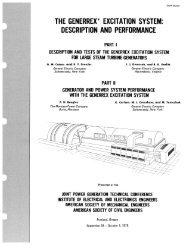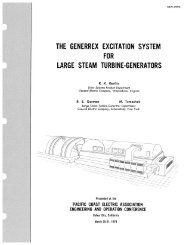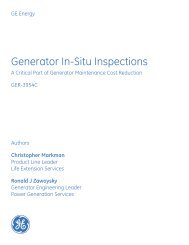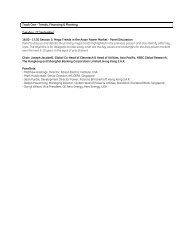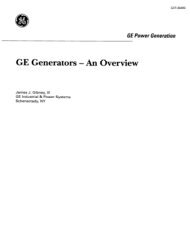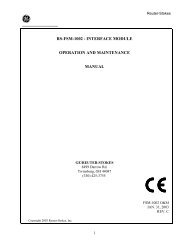GER 3568G - Dry Low NOx Combustion Systems for ... - GE Energy
GER 3568G - Dry Low NOx Combustion Systems for ... - GE Energy
GER 3568G - Dry Low NOx Combustion Systems for ... - GE Energy
Create successful ePaper yourself
Turn your PDF publications into a flip-book with our unique Google optimized e-Paper software.
<strong>Dry</strong> <strong>Low</strong> NO x <strong>Combustion</strong> <strong>Systems</strong> <strong>for</strong> <strong>GE</strong> Heavy-Duty Gas Turbines<br />
approximately 70–100% of natural gas while<br />
still maintaining low emissions.<br />
To meet these requirements an updated version<br />
of the DLN-2, called the DLN-2+, was developed.<br />
The DLN-2+ retains the basic architecture<br />
of the DLN-2 with adaptations <strong>for</strong> both the<br />
new requirements and to improve the operability<br />
and robustness of the existing system. In<br />
comparison to the DLN-2, the major changes<br />
are concentrated in the fuel nozzle and endcover<br />
arrangement (See Figure 28). Both the<br />
endcover and fuel nozzle have substantially<br />
enlarged fuel passages <strong>for</strong> the increased volumetric<br />
flow of fuel. In addition the fuel nozzle<br />
(See Figure 29), was redesigned <strong>for</strong> further<br />
improvements in flame holding margin,<br />
reduced pressure drop, and improved diffusion-flame<br />
stability.<br />
The additional gains in flame-holding velocity<br />
margin result from cleaner aerodynamics in the<br />
premixers. This is achieved via a new swirler<br />
design, which incorporates fuel injection directly<br />
from the swirler surface. Each swirler vane<br />
comprises a turning vane and an upstream<br />
straight section. The straight section is hollow<br />
and houses the fuel manifolds plus the discrete<br />
injection holes. Upstream of the swirler an inlet<br />
flow conditioner improves the character of the<br />
flow entering the premixer, while downstream<br />
an integral outer shroud eliminates any poten-<br />
Figure 28. Parts highly modified <strong>for</strong> DLN-2+ as<br />
compared to DLN-2<br />
Figure 29. DLN-2+ fuel nozzle<br />
tial flow disturbances after the point of fuel<br />
injection. The improvement in aerodynamics<br />
also reduces the overall system pressure drop to<br />
the level required by the new cycle.<br />
The nozzle-tip geometry and the improvements<br />
in diffusion flame stability allow the use of a diffusion<br />
flame on every nozzle. This eliminates<br />
the lean-lean mode of the DLN-2 and results in<br />
the simplified staging methodology shown in<br />
Figure 30.<br />
A further simplification illustrated in Figure 30 is<br />
the elimination of the DLN-2 Quaternary fuel<br />
system. This is achieved through the use of biradial<br />
fuel staging in each swirler vane. In this<br />
design the radial fuel injection balance can be<br />
adjusted via fixed orifices on the endcover as<br />
part of the system setup procedure.<br />
Overall, the fuel nozzle and endcover arrangement<br />
of the DLN-2+ can accept fuels with<br />
Wobbe Index ranging from 28 to 52. The fuel<br />
<strong>GE</strong> Power <strong>Systems</strong> ■ <strong><strong>GE</strong>R</strong>-<strong>3568G</strong> ■ (10/00) 15<br />
PM4<br />
4<br />
4<br />
1<br />
4<br />
4<br />
PM1<br />
D5 - Diffusion Flame on All<br />
PM4 - Premixed Flame on “4”<br />
PM1 - Premixed Flame on “1”<br />
D5<br />
D5<br />
D5 + PM1 + PM4<br />
PM1 + PM4<br />
IGNITION to<br />
LOW LOAD<br />
LOW LOAD to<br />
PREMIX TRANSFER<br />
PREMIX TRANSFER<br />
to BASE LOAD<br />
Premix Dynamics Control: PM4/PM1 Fuel Split<br />
Load Reject to Underlined Mode<br />
Figure 30. DLN-2+ staging methodology



